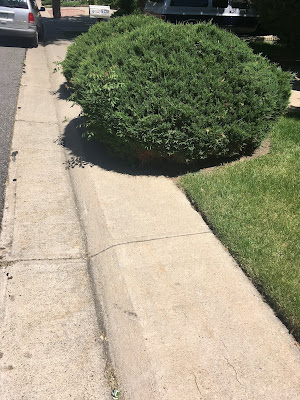 |
| Dr. Jekyll lives on the left. Poorly lit sidewalks with sodium streetlights meant for cars, not people |
by Greg Saville
What’s up with sidewalks? Walkability might be the gateway to a friendlier and safer city, but it requires a high-quality place to walk with interesting destinations. My walks of late uncovered some big-time flops. What are designers thinking when they create sidewalks?
 |
| Shrubs 1. Sidewalk 0 Too narrow and obstructed by private landscaping |
 |
| Salvation lies elsewhere. This church dismisses walkers by fencing front stairways |
Too often sidewalks are poorly designed and they end with no destination.
 |
| Logic lost! Warning walkers of a crosswalk, but forcing them to walk onto the street to avoid the sign |
SMART GROWTH
In the planning movement called Smart Growth, walkability plays an important role. One attempt to measure walkability is The Walk Score, but it is far from ideal (try it).
 |
| Activating a sidewalk with lighting, benches, and a night-time economy |
My current address has a measly Walk Score of 46, making it car dependent. Yet, nearby are trails, a lake, park, and mountain views. My former address scored a dazzling 84; In one direction there were great restaurants, parks, a library, coffee shops, school, and trails. Yet, in another, you could just as easily get caught between gang shootings. Obviously, Walk Scores say nothing about neighborhood quality.
 |
| Interesting design, colors & lighting attracts people |
 |
| Street artists at night bring culture to dead streets |
Leave a comment
Please add comments to SafeGrowth. I will post everyone except posts with abusive, off-topic, or offensive language; any discriminatory, racist, sexist or homophopic slurs; thread spamming; or ad hominem attacks.
If your comment does not appear in a day due to blogspot problems send it to safegrowth.office@gmail.com and we'll post direct.